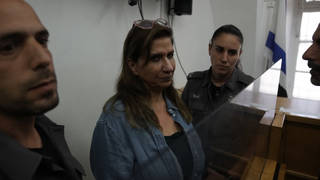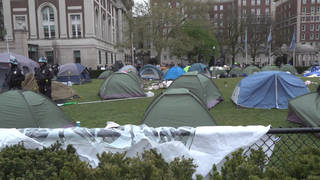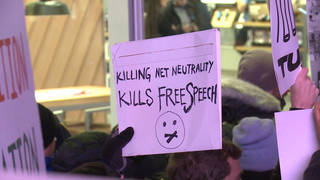
Topics
Guests
- Mitsuko Herrerapolicy adviser for Montgomery County, Maryland’s Department of Technology Services. She’s a member of the Federal Communications Commission’s Consumer Advisory Committee.
Many cable companies refuse to list the titles of shows that air on public access television stations in their on-screen guides. Now media activists are pushing for the Federal Communications Commission (FCC) to intervene.
In 2010, President Obama signed into law the 21st Century Communications and Video Accessibility Act (CVAA), which aims to make modern digital media platforms fully accessible to people who are deaf, hard of hearing, blind or with low vision. The CVAA will be implemented largely through rules drafted and enforced by the FCC, a regulatory body that is widely criticized as being too close to the industries it is supposed to regulate. Today we look at how the FCC is implementing two sections of the CVAA. Sections 204 and 205 of the law specify that video service and equipment providers make it easier for users to turn on closed captioning, and also require that on-screen channel guides be presented in a way that allows for the text on the screen to be audio interpreted, so that people who are blind or have low vision, can hear the program descriptions. For years now, established cable companies, along with new video service providers like AT&T and Verizon, have been downgrading the capacity of PEG TV channels, including the elimination of detailed, on-screen program descriptions from these noncommercial, community media institutions, effectively marginalizing the channels and the content they provide. We speak with Mitsuko Herrera, a member of the Federal Communications Commission’s Consumer Advisory Committee.
AMY GOODMAN: This is Democracy Now!, democracynow.org, The War and Peace Report. I’m Amy Goodman, with Nermeen Shaikh.
NERMEEN SHAIKH: We now discuss another media issue. In 2010, President Obama signed into law the 21st Century Communications and Video Accessibility Act, or CVAA, which aims to make modern digital media platforms fully accessible to people who are deaf, hard of hearing, blind or with low vision. The CVAA will be implemented largely through rules drafted and enforced by the FCC, the Federal Communications Commission, a regulatory body that is widely criticized as being too close to the industries it’s supposed to regulate.
Today we look at how the FCC is implementing two sections of the CVAA. Sections 204 and 205 of the law specify that video service and equipment providers make it easier for users to turn on closed captioning, and also require that on-screen channel guides be presented in a way that allows for the text on the screen to be audio interpreted, so that people who are blind or have low vision can hear the program descriptions.
AMY GOODMAN: This rule-making procedure has attracted hundred of comments to the FCC, many of which are from providers of PEG television channels, or “public access, educational, and government access” channels. For years now, established cable companies, along with new video service providers like AT&T and Verizon, have been downgrading the capacity of PEG TV channels, including the elimination of detailed, on-screen program descriptions from these noncommercial, community media institutions, effectively marginalizing the channels and the content they provide.
To help explain what’s at stake with this arcane rule-making process at the FCC, where industry lobbyists hold tremendous influence, we’re joined by Mitsuko Herrera, policy adviser for Montgomery County, Maryland’s Department of Technology Services. She’s a member of the FCC’s Consumer [Advisory] Committee.
Why don’t you lay out what’s at stake? And I think part of why this can all happen is that people don’t understand what’s going on, Mitsuko. So in very lay terms, what’s going on?
MITSUKO HERRERA: Well, what really is at stake is that many in the industry have voluntarily tried to make video program guides, the on-screen guides, more accessible, but other ones have not. And so, Congress stepped in and said that we need a rule, and the FCC is drafting the regulations which enforce that rule.
NERMEEN SHAIKH: So, Mitsuko, could you talk about which industries have made video on-screen guides more difficult to access?
MITSUKO HERRERA: Well, the problem is, is that for a lot of media companies now, they’re national in scope. And so what they tend to do is they provide information about national programs and very little information about local programs. So, for example, there are stations that carry Democracy Now!, stations like Cambridge Community Media, Dakota Media Access and TV Santa Barbara; they carry Democracy Now! with closed captions, but if I go and look on the on-screen guide, it would not note, and I would not, as a person who wants to use closed captions, know that this is a closed-caption program. We did a study, and we found that 67 percent of people use the channel guide to determine what to watch. So if you don’t have information on that guide, increasingly you’ll be shut out.
What several local media groups have asked for is that the FCC go further and actually make these rules meaningful, by requiring that cable and satellite operators and so forth carry information about local programs. So they describe to you the channel name, the program title and a short description of what you’re about to watch. Many in the disability community have noted that they cannot find and determine whether a program has closed captioning or video descriptions for those with vision disabilities without having to actually watch the program, move through the titles. And so, what they want is to simply be able to see what’s on beforehand. And that was testimony that was actually presented to Congress by an Iraq War veteran who basically said, “I pay for this service. I want to be able to access it. As a person with a vision disability, I can’t tell what it is.”
AMY GOODMAN: Now, I just want to show a on-screen comparison on Verizon FiOS, for example, in New York City, to make this point. And especially for those who don’t watch TV as much, they may not understand. For all the local programming—I mean, Time Warner, for example, in New York doesn’t have this. They actually do ID every single, you know, station, whether it’s Manhattan Neighborhood Network, CUNY TV or MSNBC, and they have all the programs listed, like everyone else. But on Verizon FiOS, there’s just one channel after another that says “local”—I think it’s “local origination.” And it never—
MITSUKO HERRERA: Correct.
AMY GOODMAN: —lists a station. And then, within that—let’s say you go to Manhattan Neighborhood Network in New York City—it’s four-hour chunks, so it’ll say, “8:00 to noon, noon to 4:00.” So if you want to record a show, if you want to TiVo it, you have to record all four hours. But because it’s not identified, you can’t do a daily record, like people say, you know, do all the Law & Order shows, for example. You can’t do that on—so, you have very much diminished capacity. And as you were saying, if you do a search for a channel, you won’t find it, because it’s not listed. Democracy Now! is not listed. CUNY Television is not listed. You have no idea what all these channels are. Now, what’s the difference between the phone companies, the telecoms, like Verizon and AT&T—I mean, I’m talking about Verizon FiOS that doesn’t list any of these local programming, programs or stations—and the cable companies, like Time Warner, who do?
MITSUKO HERRERA: Well, the—in one sense, for AT&T and Verizon, when they built out the system, they were at a more regional level. However, there is a fix that’s possible. It simply requires an investment. And that’s what we’re hoping the FCC will do. For cable operators, it’s a mixed bag. In some cases, like Time Warner in New York, they will carry it. In Montgomery County, Comcast carries information. However, if you go to a Comcast system in another state, they don’t carry that information. So, that’s the problem with a voluntary rule, is that some people do it, and some people don’t. If everybody was doing it, there wouldn’t have been a need to enact the federal statute in the first place.
NERMEEN SHAIKH: Well, the National Association—
MITSUKO HERRERA: And what you’re also seeing—and I think you raised a good point about, particularly, is that the other features don’t work, so you can’t record it on your DVR, you can’t find it again. If I’m watching a program, I can’t tell what it is that I’m watching. And for a person who has a vision disability, it’s even worse, because that’s all you’ll see. You can’t necessarily turn to the channel and then determine what it is you’re watching. And what will end up happening is, is that the cable manufacturers are looking at new technology, which really functions much more like a Siri, so you’ll be able to go to your television and verbally say, “Find sports. Find Democracy Now!” But if it’s not listed and that information isn’t on the guide, the search features don’t work. And that means, increasingly, that independent media gets blocked out from being accessible in the ways that most people now use to watch television.
NERMEEN SHAIKH: Well, the National Association of Counties, the National Association of Telecommunications Officers and Advisors and the U.S. Conference of Mayors wrote in their joint filing to the FCC, quote, “In order for audible on-screen menus to have functional utility to the visually impaired, the on-screen menu itself should be populated with information that is meaningful and helpful in program selection. In order to provide accessibility, the cable operator should be required to carry the program title as provided by the local government authority that produces local PEG programs. Currently, many local PEG programs are displayed on the on-screen menu as simply 'local government access.'” So, Mitsuko, could you talk about how you expect this to change, whether you think it will now?
MITSUKO HERRERA: Well, the FCC has an obligation to issue a final rule in this proceeding by October of this year. So, there are many local, independent stations who have filed comments at the FCC noting that this a problem, so that the FCC has a clear record that action is needed. The FCC can enact a rule which requires that local cable operators provide the program guide option to local stations. So, we’re not saying that—if you don’t have a guide, you don’t have to offer one, but if you do have a guide, you have to make it so that local, independent media has the ability to have their program information viewable on the guide.
AMY GOODMAN: How do they justify leaving them out? I mean, for Verizon FiOS, what if they just didn’t say ”MSNBC,” they just said “national network,” and it was just, you know, four-hour chunks through the day? Why do they make this decision?
MITSUKO HERRERA: Well, I mean, that’s a—that’s an interesting—
AMY GOODMAN: What do they gain by this decision to diminish the value of local programming?
MITSUKO HERRERA: Well, I think that it becomes an ever-winding death spiral, where you sort of say, “Well, people aren’t watching it—of course, we’ve made it very difficult for people to watch it—so, therefore, we really shouldn’t have more local stations. We should just fill them with more reality TV, or we should fill them with more paid programming.” So, in a sense, if you—if you have corporations who do things that make it easy and accessible for people to view local, independent media, you probably feed an appetite for people to want more of that in their communities. And those are—and that means that there’s channel space that they have to devote to it. It’s worth noting that AT&T has in its communities segregated all of the local media onto a channel 99 platform, so it doesn’t even appear on the guide.
AMY GOODMAN: Explain that, for people who don’t have AT&T. Explain what AT&T has done.
MITSUKO HERRERA: So what AT&T will do is that they will go and take all of the local media, noncommercial, so where they’re required to have public broadcast stations and the local commercial markets, those channels appear on the guide. For all of the public, educational, government access channels—so if you want access to find out what’s happening in your local community, if you want a place where people can independently produce stories—those channels are all segregated, and you have to go to channel 99, and then you’ll have to flip through the list of all the channels that they may carry. So there may be anywhere from 20 to a hundred different channels that are listed. And then you’ll have to go and wait for it to load up, and then it will go to that channel. And then if you want to switch to—
AMY GOODMAN: Load like a video loads.
MITSUKO HERRERA: Exactly, exactly, with all the attendant delays. And, in fact, they had testimony in Congress where in about the time that I was speaking is about how long that it took to get to a particular channel. And if you want to go to a different channel, you have to go through that same process. You can’t flip back and forth between channels. You can’t find out what programs are being offered. And AT&T will talk about this as “Isn’t this a wonderful thing, because we’ve given you access to all these channels on your television?”—although it’s not the same type of access that we give you to commercial stations, it’s not necessarily easy for the viewers to find. And, lo and behold, what they’ll start to find is that as people can’t find your programming, and they don’t know what you’re producing, they stop watching. And then the companies can come in and say, “Well, people aren’t watching. Maybe we shouldn’t carry these channels.”
AMY GOODMAN: So what is happening today? Why is there a deadline of today, Wednesday, August 7th?
MITSUKO HERRERA: The deadline today is a filing. The FCC, because they have to create a rule by October, they’ve asked for comments. And what they’ve—people have submitted comments, and Wednesday was the deadline for reply comments to be sent. However, people can still file late, so it’s really—the deadline isn’t so much the driver. What’s important is that people note: “I want access. I want to be able to view, on the guide, information about the program I’m watching. I want to be able to know, before I watch a local program, whether it has closed captions or video descriptions.”
NERMEEN SHAIKH: Mitsuko, can you talk more broadly about the quality of broadband services in the U.S. and the role of municipal broadband networks in making up for shortfalls in commercial offerings?
MITSUKO HERRERA: Well, for the most part, we still haven’t really solved the problem of, one, how do you build broadband to places where it’s expensive to build, where there is a low population density, typically? Sometimes you can have expenses in urban areas, but they tend to—the networks tend to be—pay for themselves, because you can get more subscribers per mile. Community networks are places where in—communities, they sort of fall under two categories. One category can be that there’s local governments who build their own networks as a way of more cost-effectively providing services, whether that’s broadband to school, public safety networks and so forth. In other areas, there are community networks where they serve every household. Those communities tend to be places where they had a municipal electric system, so it was cost-effective and they already reached every home. And in those cases, what they’re really trying to do is to say, for whatever reason, the commercial entity decided that our community wasn’t worth the investment. And local communities are saying for themselves, “We are worth the investment. We need to have broadband technology and access to it in our homes in order to be part of a modern economy.”
And what many local governments are doing, as well, is that they’re recognizing that about half the people who have access to broadband and could afford it have decided not to get it, because they really don’t see what’s useful about it. Seniors disproportionately make up a large percentage of those groups. So what they are doing then is partnering with other groups to provide training, so that people understand this is how I can make my business more effective. For example, Etsy is a site where people sell homemade goods, homemade crafts. For a lot of people, they’re not aware of that. But suddenly it opens up a whole new home economy.
AMY GOODMAN: We want to thank you very much, Mitsuko, for joining us. Mitsuko Herrera is a policy adviser for Montgomery County, Maryland’s Department of Technology Services, member of the Federal Communications Commission’s Consumer Advisory Committee. This is_Democracy Now!_, democracynow.org, The War and Peace Report. I’m Amy Goodman, with Nermeen Shaikh.











Media Options